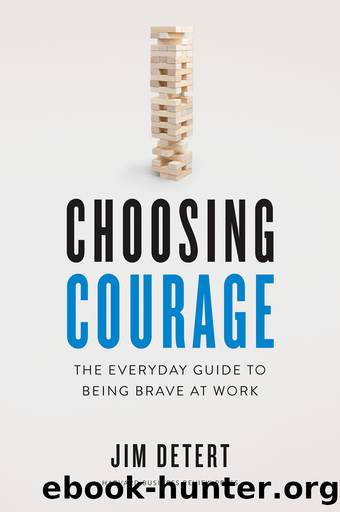Choosing Courage by Jim Detert

Author:Jim Detert
Language: eng
Format: epub
Publisher: Harvard Business Review Press
Published: 2021-06-15T00:00:00+00:00
CHAPTER 7
Managing the Message
Melinda, a senior product manager at a major consumer goods company, was in a tough spot. Based on new science, the R&D team had recently reclassified a key ingredient in a major product to its lowest rating, which essentially meant âdonât use.â Following this, R&D had spent millions of dollars over the past six months searchingâto no availâfor an alternative ingredient that would be safer but equally as effective. Melinda was pressed for time. Since the companyâs annual product safety report was due in a month and would be shared with the public, she had to recommend a plan to the senior team.
As Melinda saw it, she had three options: (1) recommend sticking with the existing product for now, even though it still contained an undesirable (but legal) chemical, (2) recommend switching to the new product, knowing that it was inferior but unquestionably safer, or (3) recommend removing the old product from the market until R&D came up with a safer alternative that also worked well.
None of these options was ideal. Sticking with the old product seemed to violate the companyâs commitment to safe products. Using the new but inferior product could anger customers and lead some to stop using the companyâs products. Taking the product completely off the market until a better alternative was found meant forgoing about 5 percent of total company revenue during that period.
After days of agonizing about the choice, Melinda and her team settled on recommending the second optionâreplacing the existing product with the safer but less effective alternative. She knew that it was risky: evidence from prior moves to safer alternatives was mixed. In some cases, sales had stayed the same or gone up; in others, sales had definitely gone down initially. Given this history, Melinda had to figure out how to frame her recommendation to the CEO and top management team. How could she convince the array of people on that team that this was the best (or least bad) way to live the companyâs values and also minimize financial downside?
___________
Melinda has decided what to recommend, but sheâs still got a lot of choices about how to make her recommendation. Whom, if anyone, should she invite to join her in making the recommendation? What data will she use, and in what kind of presentation format? What kind of message framing will make her recommendation most compelling to the executives assembled? Should she lead with the cultural values that support her recommendations or focus on the short- and long-term financial implications? Should she describe her recommendation as an opportunity to be pursued or a threat to be dealt with? Can she help the executives see this as somehow advancing their agenda rather than just being a major problem?
Like Melinda, you have a host of options when you need to persuade others. You can consider inviting others to help you make your case, use the right data the right way, and utilize various framing strategies that my colleagues who study âissue selling,â âvoice,â and âpersuasionâ have found to increase effectiveness.
Download
This site does not store any files on its server. We only index and link to content provided by other sites. Please contact the content providers to delete copyright contents if any and email us, we'll remove relevant links or contents immediately.
Tools of Titans by Timothy Ferriss(7984)
Change Your Questions, Change Your Life by Marilee Adams(7466)
Deep Work by Cal Newport(6694)
Man-made Catastrophes and Risk Information Concealment by Dmitry Chernov & Didier Sornette(5765)
Playing to Win_ How Strategy Really Works by A.G. Lafley & Roger L. Martin(5646)
Digital Minimalism by Cal Newport;(5482)
Big Magic: Creative Living Beyond Fear by Elizabeth Gilbert(5449)
The Slight Edge by Jeff Olson(5253)
Ego Is the Enemy by Ryan Holiday(5074)
The Motivation Myth by Jeff Haden(5058)
Stone's Rules by Roger Stone(4930)
The Laws of Human Nature by Robert Greene(4859)
Tuesdays with Morrie by Mitch Albom(4493)
Rising Strong by Brene Brown(4268)
Eat That Frog! by Brian Tracy(4253)
Skin in the Game by Nassim Nicholas Taleb(4049)
The Money Culture by Michael Lewis(3935)
Bullshit Jobs by David Graeber(3915)
Skin in the Game: Hidden Asymmetries in Daily Life by Nassim Nicholas Taleb(3801)
